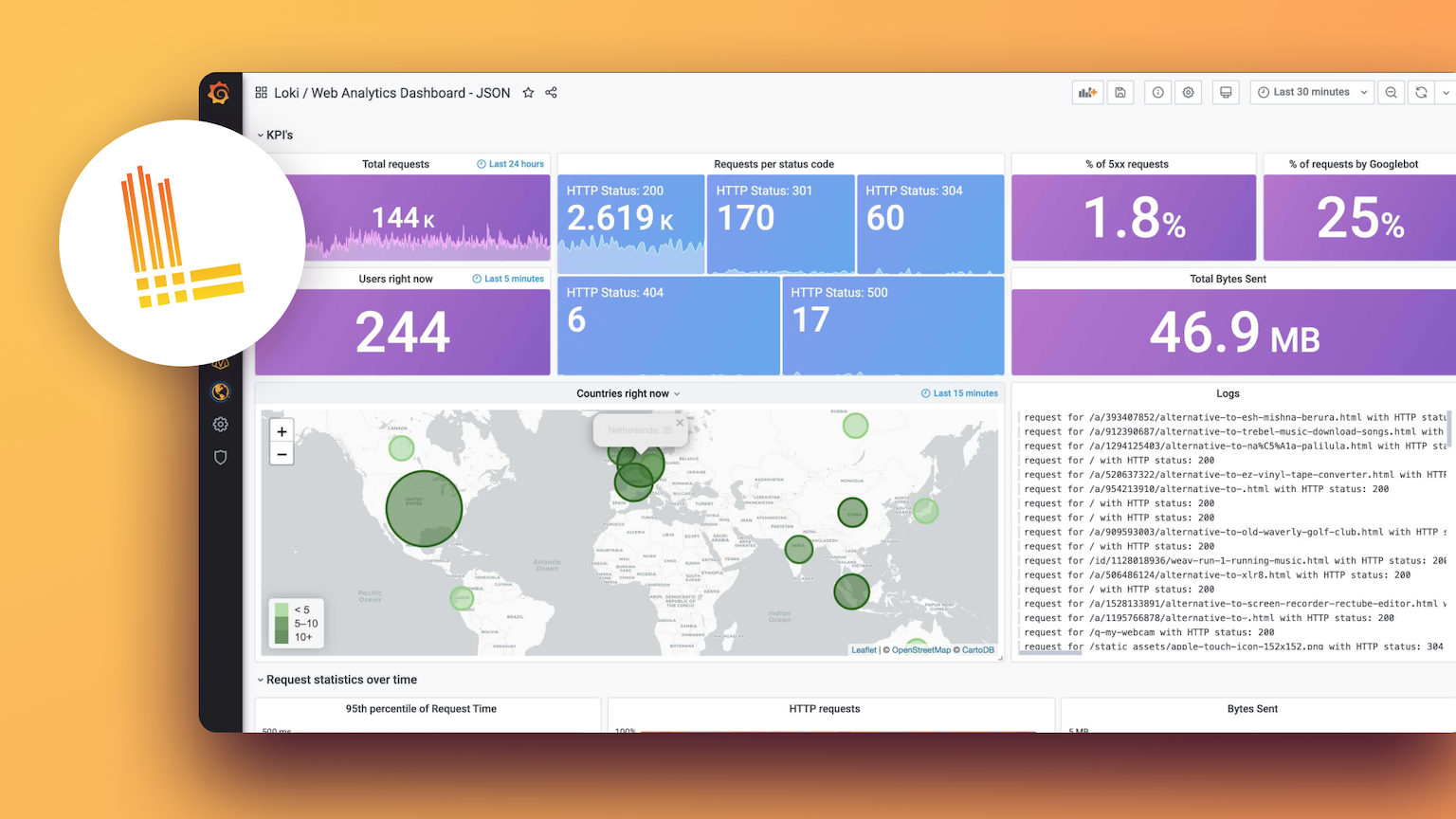Plugins 〉Pixie Grafana Datasource Plugin
Pixie Grafana Datasource Plugin
What is Pixie?
Pixie is an observability platform for Kubernetes. It allows developers to debug, monitor, and explore their applications. Pixie uses eBPF to automatically capture telemetry data without the need for manual instrumentation.
This plugin allows Grafana users to use Pixie as a datasource in their Grafana dashboards. It can be used to visualize the following data automatically collected in Pixie:
Protocol tracing and metrics: Pixie automatically collects full-body messages between the pods of your applications. Supports protocols such as HTTP, MySQL, DNS, and Redis. You can also expose application metrics such as request latency, error rate, and throughput.
Resource metrics: CPU, memory and I/O metrics for your pods. For more information, see the Infra Health tutorial.
Network metrics: Network-layer and connection-level RX/TX statistics. For more information, see the Network Monitoring tutorial.
JVM metrics: JVM memory management metrics for Java applications.
Application CPU profiles: Sampled stack traces from your application.

Getting started
Install Pixie on your Kubernetes cluster.
Installing the Plugin
On Grafana Cloud
The Pixie datasource plugin is available on Grafana Cloud, which makes it easy to install Grafana plugins to your Grafana Cloud instance.
On a local Grafana instance
In order to deploy to a local Grafana instance, you can run the following command:
grafana-cli plugins install pixie-pixie-datasource
Using the plugin
Check out the Grafana Pixie plugin tutorial and example queries.
Pixie's data can be accessed using PxL, the query language for the data it collects. This datasource allows Grafana users to enter a PxL script when using Pixie as a datasource for a panel in their dashboard.
Development
If you want to add a new feature to the plugin, check out CONTRIBUTING.md. We welcome the contributions of the community!
Clone the repo
git clone git@github.com:pixie-io/grafana-plugin.git
Building from source: front-end
Once the repo has been cloned, please:
Install dependencies
yarn installBuild plugin in development mode or run in watch mode
yarn devor
yarn watchBuild plugin in production mode
yarn build
Building from source: back-end
Update Grafana plugin SDK for Go dependency to the latest minor version:
go get -u github.com/grafana/grafana-plugin-sdk-goBuild backend plugin binaries for Linux, Windows and Darwin:
mage -v
Installing the dev version of the plugin
Copy the
distfolder to your Grafana plugins directory.Edit your Grafana configuration file to detect the plugin binaries. Additional details here.
Grafana Cloud Free
- Free tier: Limited to 3 users
- Paid plans: $55 / user / month above included usage
- Access to all Enterprise Plugins
- Fully managed service (not available to self-manage)
Self-hosted Grafana Enterprise
- Access to all Enterprise plugins
- All Grafana Enterprise features
- Self-manage on your own infrastructure
Grafana Cloud Free
- Free tier: Limited to 3 users
- Paid plans: $55 / user / month above included usage
- Access to all Enterprise Plugins
- Fully managed service (not available to self-manage)
Self-hosted Grafana Enterprise
- Access to all Enterprise plugins
- All Grafana Enterprise features
- Self-manage on your own infrastructure
Grafana Cloud Free
- Free tier: Limited to 3 users
- Paid plans: $55 / user / month above included usage
- Access to all Enterprise Plugins
- Fully managed service (not available to self-manage)
Self-hosted Grafana Enterprise
- Access to all Enterprise plugins
- All Grafana Enterprise features
- Self-manage on your own infrastructure
Grafana Cloud Free
- Free tier: Limited to 3 users
- Paid plans: $55 / user / month above included usage
- Access to all Enterprise Plugins
- Fully managed service (not available to self-manage)
Self-hosted Grafana Enterprise
- Access to all Enterprise plugins
- All Grafana Enterprise features
- Self-manage on your own infrastructure
Grafana Cloud Free
- Free tier: Limited to 3 users
- Paid plans: $55 / user / month above included usage
- Access to all Enterprise Plugins
- Fully managed service (not available to self-manage)
Self-hosted Grafana Enterprise
- Access to all Enterprise plugins
- All Grafana Enterprise features
- Self-manage on your own infrastructure
Installing Pixie Grafana Datasource Plugin on Grafana Cloud:
Installing plugins on a Grafana Cloud instance is a one-click install; same with updates. Cool, right?
Note that it could take up to 1 minute to see the plugin show up in your Grafana.
Warning
Plugin installation from this page will be removed in February 2026. Use the Plugin Catalog in your Grafana instance instead. Refer to Install a plugin in the Grafana documentation for more information.
Installing plugins on a Grafana Cloud instance is a one-click install; same with updates. Cool, right?
Note that it could take up to 1 minute to see the plugin show up in your Grafana.
Warning
Plugin installation from this page will be removed in February 2026. Use the Plugin Catalog in your Grafana instance instead. Refer to Install a plugin in the Grafana documentation for more information.
Installing plugins on a Grafana Cloud instance is a one-click install; same with updates. Cool, right?
Note that it could take up to 1 minute to see the plugin show up in your Grafana.
Warning
Plugin installation from this page will be removed in February 2026. Use the Plugin Catalog in your Grafana instance instead. Refer to Install a plugin in the Grafana documentation for more information.
Installing plugins on a Grafana Cloud instance is a one-click install; same with updates. Cool, right?
Note that it could take up to 1 minute to see the plugin show up in your Grafana.
Warning
Plugin installation from this page will be removed in February 2026. Use the Plugin Catalog in your Grafana instance instead. Refer to Install a plugin in the Grafana documentation for more information.
Installing plugins on a Grafana Cloud instance is a one-click install; same with updates. Cool, right?
Note that it could take up to 1 minute to see the plugin show up in your Grafana.
Warning
Plugin installation from this page will be removed in February 2026. Use the Plugin Catalog in your Grafana instance instead. Refer to Install a plugin in the Grafana documentation for more information.
Installing plugins on a Grafana Cloud instance is a one-click install; same with updates. Cool, right?
Note that it could take up to 1 minute to see the plugin show up in your Grafana.
Installing plugins on a Grafana Cloud instance is a one-click install; same with updates. Cool, right?
Note that it could take up to 1 minute to see the plugin show up in your Grafana.
Warning
Plugin installation from this page will be removed in February 2026. Use the Plugin Catalog in your Grafana instance instead. Refer to Install a plugin in the Grafana documentation for more information.
Installing plugins on a Grafana Cloud instance is a one-click install; same with updates. Cool, right?
Note that it could take up to 1 minute to see the plugin show up in your Grafana.
For more information, visit the docs on plugin installation.
Installing on a local Grafana:
For local instances, plugins are installed and updated via a simple CLI command. Plugins are not updated automatically, however you will be notified when updates are available right within your Grafana.
1. Install the Data Source
Use the grafana-cli tool to install Pixie Grafana Datasource Plugin from the commandline:
grafana-cli plugins install The plugin will be installed into your grafana plugins directory; the default is /var/lib/grafana/plugins. More information on the cli tool.
Alternatively, you can manually download the .zip file for your architecture below and unpack it into your grafana plugins directory.
Alternatively, you can manually download the .zip file and unpack it into your grafana plugins directory.
2. Configure the Data Source
Accessed from the Grafana main menu, newly installed data sources can be added immediately within the Data Sources section.
Next, click the Add data source button in the upper right. The data source will be available for selection in the Type select box.
To see a list of installed data sources, click the Plugins item in the main menu. Both core data sources and installed data sources will appear.
Changelog
0.0.9
- Update Grafana compatibility version
0.0.8
- Strip whitespace for API key and default cluster ID
0.0.7
- Update carousel images and Grafana README image
- Improve descriptions in script dropdown
0.0.6
- Remove redundant example query from script dropdown
0.0.5
- Fix bug where column/groupby builder selections were cleared out when changing visualization type
- Update script descriptions to indicate the visualization type to use
0.0.1
Initial release. This plugin supports Pixie as a backend datasource for Grafana. Both time range and interval macros are supported.

















